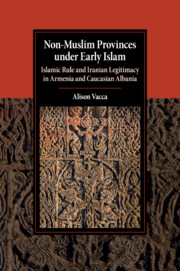 Non-Muslim Provinces under Early Islam
Non-Muslim Provinces under Early Islam Published online by Cambridge University Press: 08 September 2017
The study of the North gets a rocky start because it is particularly difficult to describe the region geographically. Very broadly speaking, Arabic sources refer to modern-day eastern Turkey and Armenia as Armenia, eastern Georgia and Azerbaijan as Albania, and northwestern Iran as Azerbaijan. Modern historians must contend with a dizzying array of Byzantine administrative districts, Armenian and Georgian toponyms, Persian provinces, multiple layers of conflicting inheritances in Arabic literature, and a plethora of petty local kingdoms in the Caucasus. Many of the terms such as Interior and Exterior Armenia appear in Greek, Armenian, and Arabic literature, although not always to refer to the same regions. The Romano-Byzantine Greater Armenia does not necessarily correspond to the same land as the Armenian Mec Hayk' or the Arabic Armīniyya l-kubrā, even if the titles are direct translations. Furthermore, the administrative units were flexible, so that there were multiple incarnations of any one of them. Armenia I was not the same under Justinian and Maurice, so we should hardly expect it to arrive unchanged in Arabic as Armīniyya l-ūlā.
To preempt the confusion of multiple definitions of each toponym, we refer here to provinces based on their definitions in Arabic geographical treatises. Although not all Arabic texts divide the provinces in the same way, we can generalize about the views of the Balkhī school as follows:
Eastern Georgian cities and cities along the Georgian–Albanian border, while part of the caliphal province, appear in the texts of the Balkhī geographers such as Iṣṭakhrī, Ibn Ḥawqal, and Muqaddasī as part of Albania. The lines between the three provinces certainly fluctuated. As the anonymous tenth-century geography Borders of the World states, “their country-sides enter into each other.”
Despite the appearance of Byzantine toponyms, Arabic geographical works, particularly those of the Balkhī school, describe the administrative geography of the caliphal North based on Sasanian antecedents. The numismatic and textual evidence demonstrates common ground between Sasanian geographical paradigms and those evident in the Marwānid and early ʿAbbāsid periods, although we do not have sufficient data from the conquest and Sufyānid periods to argue that this reflects actual administrative continuity instead of the retrojection of such continuity.
To save this book to your Kindle, first ensure no-reply@cambridge.org is added to your Approved Personal Document E-mail List under your Personal Document Settings on the Manage Your Content and Devices page of your Amazon account. Then enter the ‘name’ part of your Kindle email address below. Find out more about saving to your Kindle.
Note you can select to save to either the @free.kindle.com or @kindle.com variations. ‘@free.kindle.com’ emails are free but can only be saved to your device when it is connected to wi-fi. ‘@kindle.com’ emails can be delivered even when you are not connected to wi-fi, but note that service fees apply.
Find out more about the Kindle Personal Document Service.
To save content items to your account, please confirm that you agree to abide by our usage policies. If this is the first time you use this feature, you will be asked to authorise Cambridge Core to connect with your account. Find out more about saving content to Dropbox.
To save content items to your account, please confirm that you agree to abide by our usage policies. If this is the first time you use this feature, you will be asked to authorise Cambridge Core to connect with your account. Find out more about saving content to Google Drive.